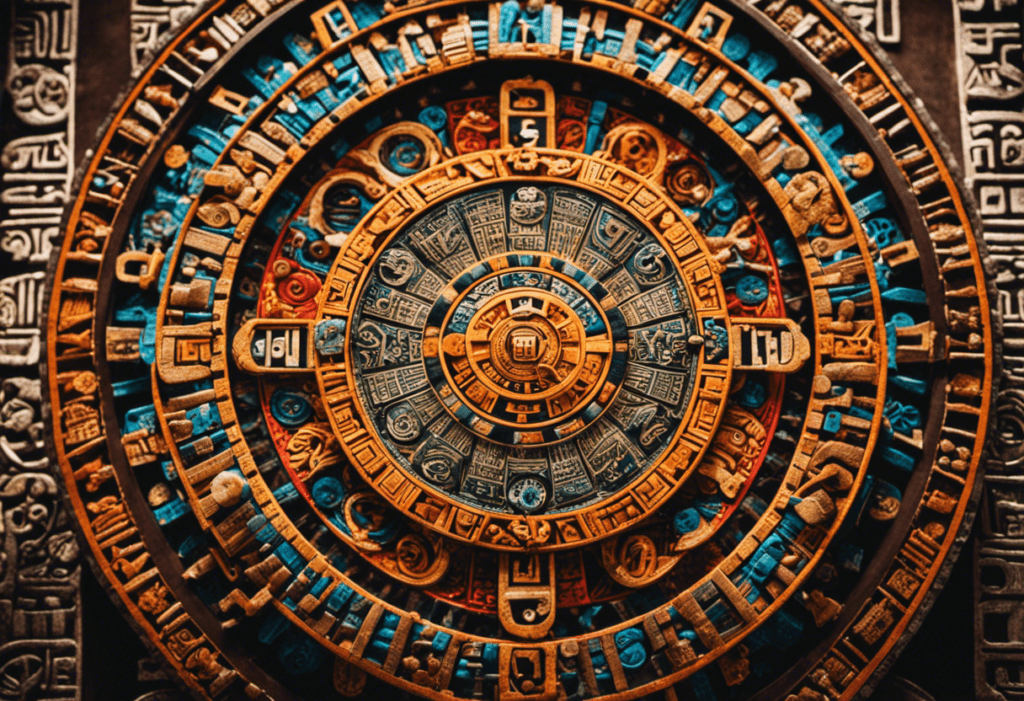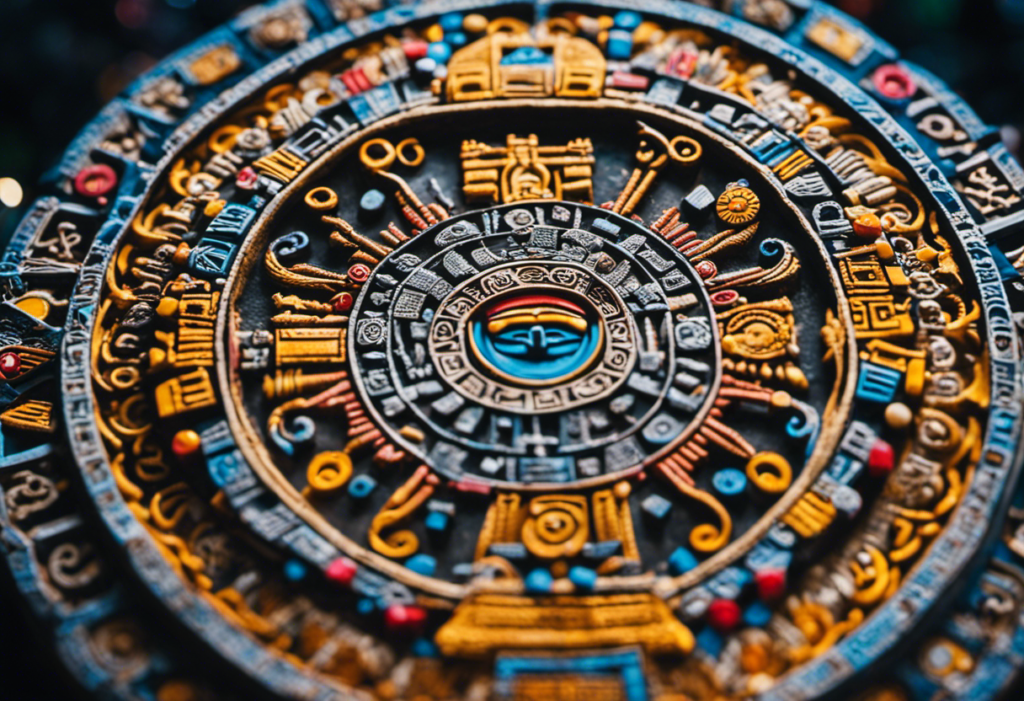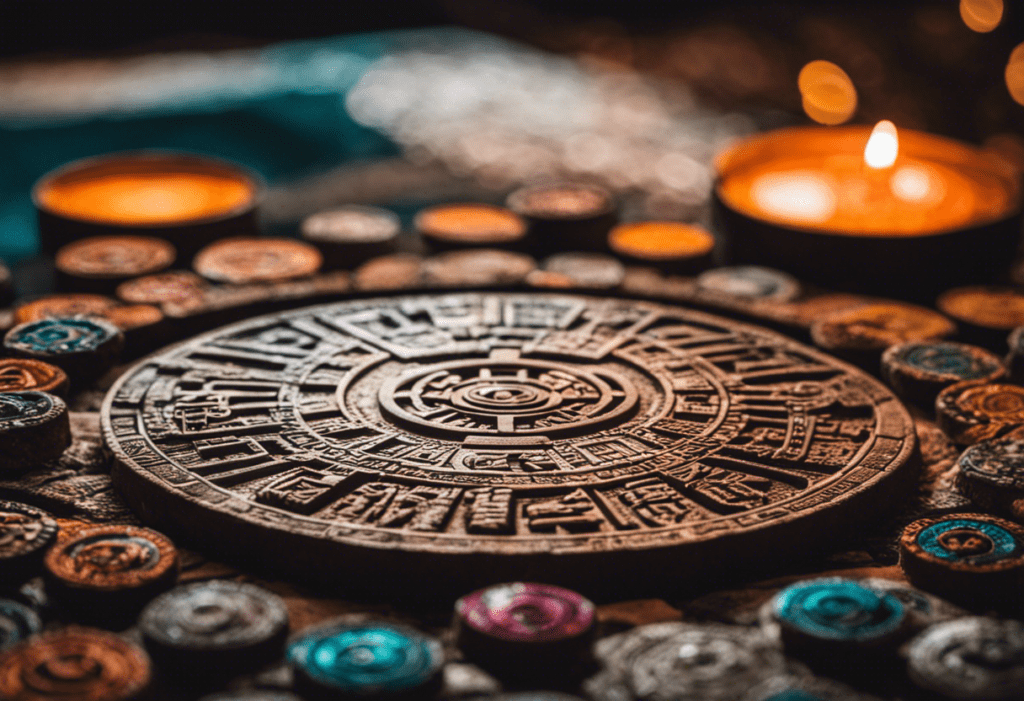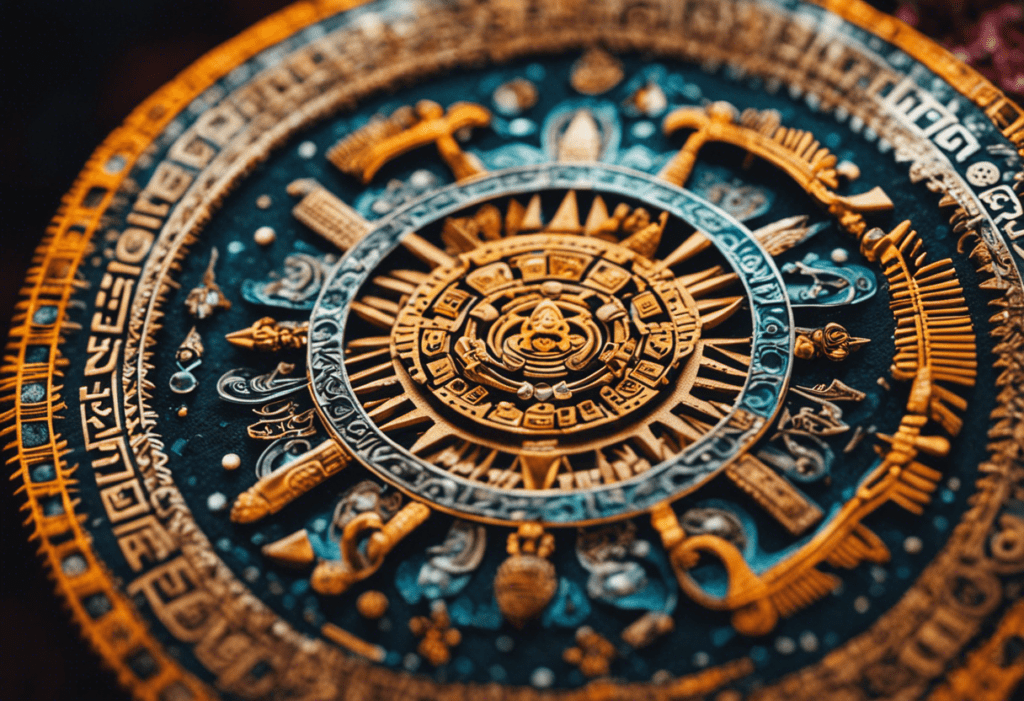In the realm of ancient civilizations, the Aztecs were renowned for their complex system of timekeeping.
At the heart of this system were the Aztec calendar wheels, intricate devices that allowed the Aztecs to comprehend the cyclical nature of time.
By decoding the symbols embedded within these wheels, scholars have gained invaluable insights into the celestial events and cultural rituals that shaped Aztec society.
This article explores the profound influence of Aztec calendar wheels, both in the ancient world and in modern times.
Key Takeaways
- The Aztec calendar system consisted of two types of calendars: the xiuhpohualli and the tonalpohualli.
- The symbols on the calendar wheels represent deities, celestial bodies, and natural elements.
- The Aztecs used the calendar wheels to track the cyclical nature of time and understand the interplay between cosmic forces.
- The calendar cycles held both divine and cultural significance for the Aztecs, guiding their religious practices, agricultural activities, and social events.
The Aztec Calendar System: An Overview
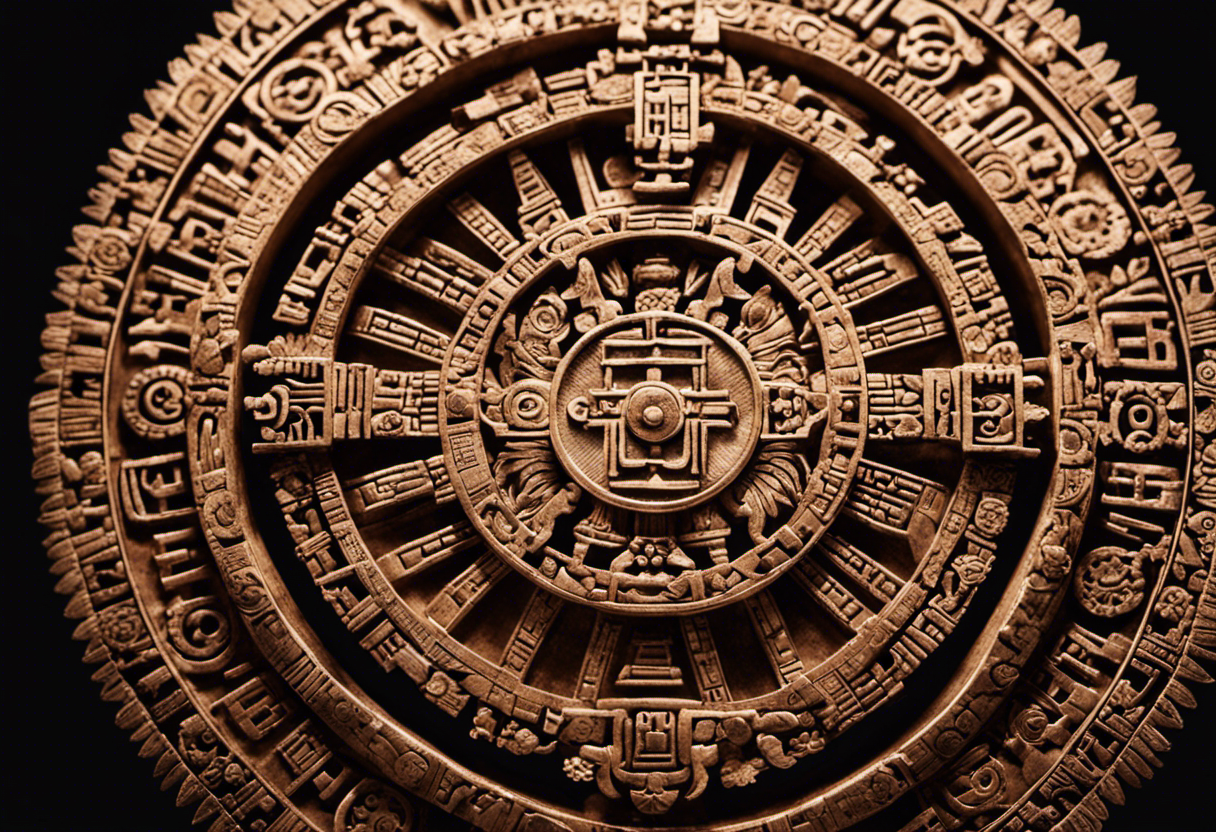

Importantly, the Aztec calendar system is a complex and intricate method of timekeeping that played a significant role in the lives and beliefs of the Aztec civilization. The Aztecs developed two types of calendars: the xiuhpohualli, which tracked the solar year, and the tonalpohualli, which followed the sacred calendar of 260 days. These calendars were not only used for tracking time but also for understanding the cyclical nature of the universe and predicting future events.
Decoding the symbols used in the Aztec calendar system was a challenging task that required deep knowledge and understanding. The xiuhpohualli, for example, consisted of 18 months, each with 20 days, and a five-day period known as the nemontemi. Each month had its unique symbol, representing the deity associated with that month. To track time accurately, the Aztecs had to align the solar and sacred calendars, which formed a larger cycle of 52 years called the Calendar Round.
The tonalpohualli, on the other hand, used a combination of 20 day signs and 13 numbers to create a cycle of 260 days. Each day had its own unique energy and significance, and it was believed that an individual’s destiny was influenced by the day they were born on.
Decoding the Symbols: Understanding Aztec Calendar Wheels
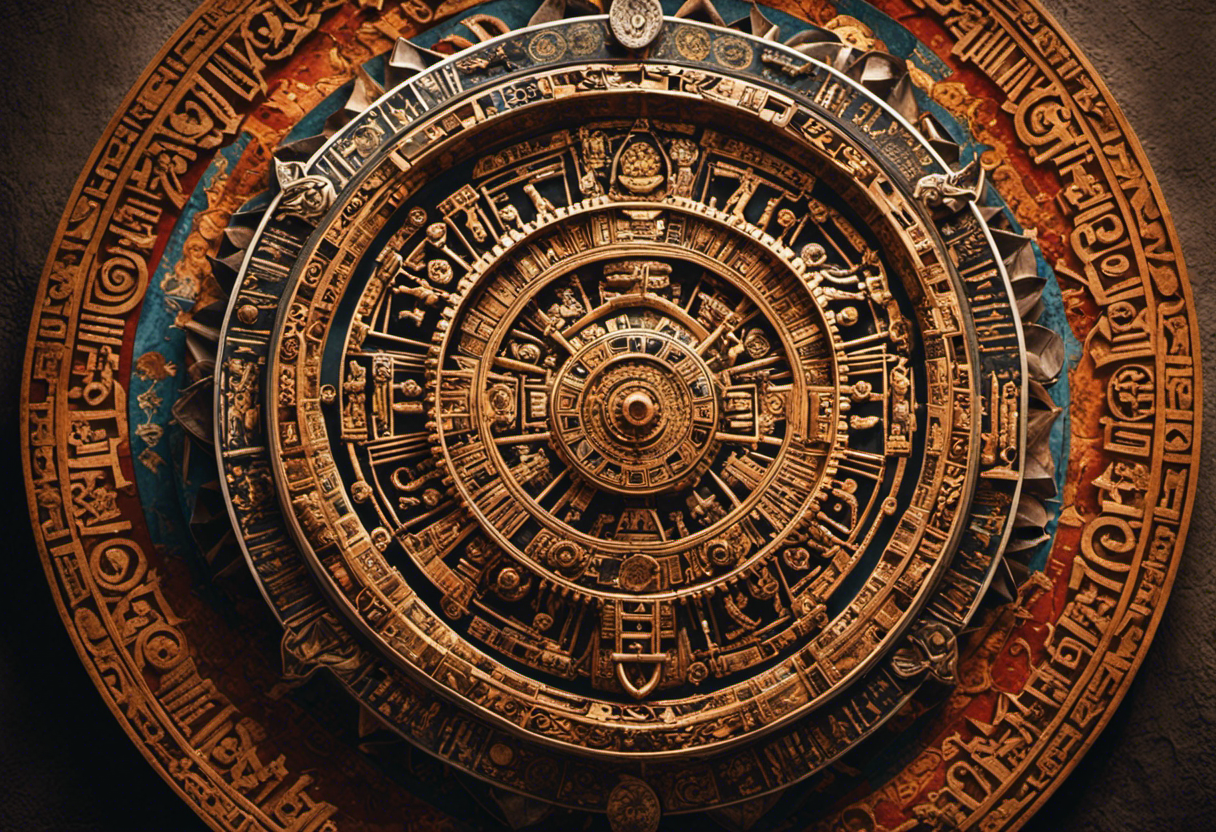

To fully comprehend the intricacies of Aztec calendar wheels, it is crucial to decipher the symbols embedded within them. These symbols hold a significant cultural significance and provide valuable insights into the beliefs and practices of the Aztec civilization. Here are some key points to consider when decoding the symbols on Aztec calendar wheels:
- Iconography:
- The symbols on the calendar wheels are rich in iconography, representing various deities, celestial bodies, and natural elements.
- Each symbol carries its own meaning and was carefully chosen to convey specific concepts and ideas.
- Cosmic Cycles:
- The symbols on the calendar wheels depict the cyclical nature of time and the Aztec understanding of the universe.
- They represent the interplay between various cosmic forces, such as the sun, the moon, and the stars.
Decoding these symbols requires a deep understanding of Aztec mythology, religious practices, and astronomical knowledge. Scholars have spent years studying and interpreting these symbols to unravel the complex system of timekeeping and cosmic understanding employed by the Aztecs. By decoding these symbols, we can gain a better understanding of the Aztec worldview and their profound connection with the natural world.
The cultural significance of these symbols cannot be overstated, as they provide a glimpse into the rich and intricate tapestry of Aztec culture.
Tracking Time: The Cyclical Nature of Aztec Calendar Cycles


The Aztec calendar wheels were not only used to measure time but also to track the cyclical nature of time.
One of the key aspects of the Aztec calendar was its sacred time patterns, which were believed to hold divine significance.
Sacred Time Patterns
One of the key aspects of the Aztec calendar system is the presence of multiple sacred time patterns that help track the cyclical nature of time. These patterns are deeply intertwined with the Aztec’s sacred rituals and ancient beliefs.
To understand the sacred time patterns of the Aztec calendar system, it is important to consider two main sub-lists:
- Tonalpohualli: The Tonalpohualli is a 260-day ritual calendar that governs the daily activities of the Aztec people. It consists of 20 named days and 13 numbers, forming a cycle of unique combinations. Each day is associated with certain deities and events, providing a framework for religious ceremonies and divination practices.
- Xiuhpohualli: The Xiuhpohualli is a 365-day solar calendar that determines the agricultural and ceremonial activities of the Aztec community. It consists of 18 named months, each with 20 days, and a 5-day period known as the nemontemi. This calendar is closely tied to the seasonal changes and the cultivation of crops.
These sacred time patterns reflect the Aztec’s deep connection to their spiritual beliefs and the cyclical nature of the universe.
Calendar Symbolism Explained
Calendar symbolism in the Aztec calendar system provides a profound insight into the interconnectedness of time and the intricate cycles that govern the universe.
The Aztec calendar was more than just a tool for tracking time; it was a complex system of symbols that held deep cultural significance. Each symbol represented a specific deity or celestial body and was associated with various aspects of Aztec cosmology and mythology.
For example, the sun symbol, called ‘Tonatiuh,’ represented the sun god and was associated with the concept of creation and renewal. The moon symbol, called ‘Metztli,’ represented the moon goddess and was associated with fertility and feminine energy.
These symbols not only helped the Aztecs keep track of time but also served as a means of connecting with their spiritual beliefs and understanding the cyclical nature of existence.
Divine Significance of Cycles
With a deep understanding of the cyclical nature of the Aztec calendar cycles, one can uncover the divine significance behind the tracking of time in the ancient Aztec civilization. The Aztecs believed that time was not linear but rather cyclical, with each cycle representing a unique set of divine interpretations and cultural significance. This perspective allowed them to view time as a series of interconnected cycles, each with its own meaning and purpose.
Here are two key points to consider:
- Divine interpretations: The Aztecs believed that the cycles of the calendar were interconnected with the gods and their actions. Each cycle represented a specific divine interpretation, guiding the Aztecs in their religious practices and rituals.
- Cultural significance: The tracking of time through calendar cycles held immense cultural significance for the Aztecs. It helped them organize their religious ceremonies, agricultural activities, and social events, ensuring the harmony and balance of their society.
Through their understanding of the cyclical nature of time, the Aztecs were able to maintain a deep connection with the divine and preserve their cultural heritage.
Celestial Events: How Aztec Calendar Wheels Predicted the Stars
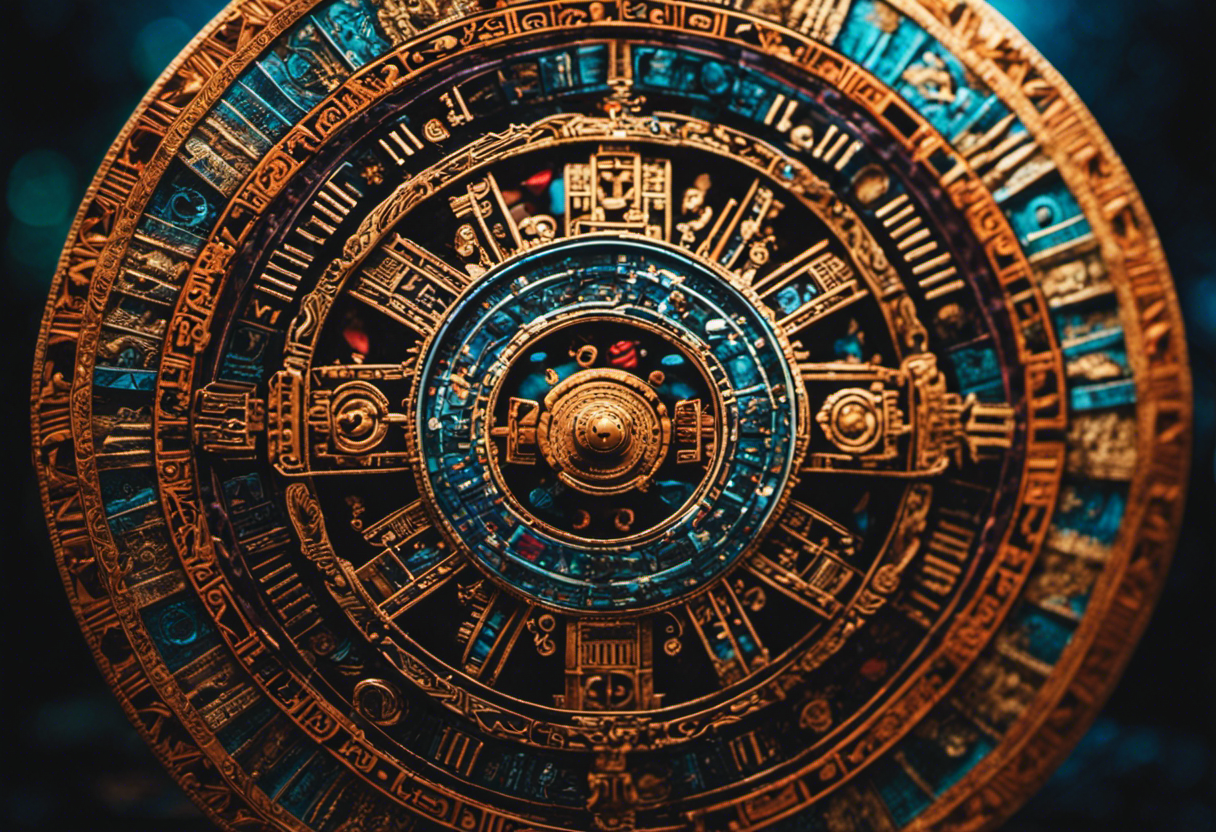

The Aztecs possessed a remarkable understanding of celestial events, evident in their sophisticated calendar system. Their calendar wheels allowed them to accurately predict and track the movements of stars and other celestial bodies.
This astronomical knowledge highlights the advanced level of scientific and mathematical expertise achieved by the Aztec civilization.
Astronomical Knowledge in Aztec Culture
Interestingly, Aztec culture possessed a deep understanding of celestial events, using their calendar wheels to accurately predict the movement of the stars. This astronomical knowledge was crucial to their society and had significant cultural significance.
Here are some key points regarding the astronomical observations and cultural significance in Aztec culture:
- Aztec calendar wheels, also known as the Sunstone or Aztec Stone of the Sun, were used to track celestial events such as solstices and equinoxes.
- The Aztecs believed that these celestial events had a direct impact on their agricultural practices and religious ceremonies.
- The accurate prediction of celestial events allowed the Aztecs to plan their agricultural activities, such as planting and harvesting crops, in harmony with the natural cycles.
- The Aztec priests played a crucial role in observing and interpreting celestial events, providing guidance to the community based on their knowledge of the stars and planets.
- The Aztecs also associated certain celestial events with specific deities, further emphasizing the cultural significance of their astronomical knowledge.
Accuracy of Celestial Predictions
The Aztec calendar wheels, also known as the Sun Stone or the Stone of the Five Eras, were intricately designed to accurately determine the positions of celestial bodies and anticipate celestial events such as solar eclipses. The wheels incorporated the movements of the sun, moon, and other celestial bodies, allowing the Aztecs to accurately forecast celestial phenomena and align their rituals and ceremonies accordingly.
The Aztec calendar wheels accurately predicted celestial events and their movements, demonstrating the advanced astronomical knowledge of the Aztec civilization. These ancient civilizations had a profound understanding of celestial phenomena and developed sophisticated methods to track and predict them.
This level of accuracy reveals the depth of knowledge possessed by the Aztecs in the field of astronomy and their ability to integrate celestial observations into their daily lives.
Rituals and Festivals: The Role of Aztec Calendar Cycles in Aztec Culture


Numerous rituals and festivals throughout the year were deeply intertwined with the cyclical nature of the Aztec calendar, shaping and defining the cultural identity of the Aztec civilization. The Aztecs believed that these rituals and festivals were essential in maintaining the harmony and balance of the universe.
The Aztec calendar, with its intricate system of cycles, provided the framework for these cultural practices, ensuring that they were performed at the appropriate times and in accordance with the cosmic order.
The Aztec calendar rituals held great cultural significance for the Aztec people. They were seen as a way to honor the gods, seek their favor, and ensure the fertility of the land. These rituals ranged from simple ceremonies performed by individuals to elaborate community-wide festivals that involved music, dance, and offerings of food and precious objects. Some of the most important rituals were associated with agricultural activities, such as planting and harvesting, while others were dedicated to specific deities or celestial events.
The festivals associated with the Aztec calendar cycles were occasions for communal celebration and religious devotion. They provided a sense of unity and identity among the Aztec people, reinforcing their connection to the natural world and the divine.
Through these rituals and festivals, the Aztecs sought to maintain the cosmic balance and ensure the prosperity and well-being of their society.
Legacy and Influence: Aztec Calendar Wheels in Modern Times
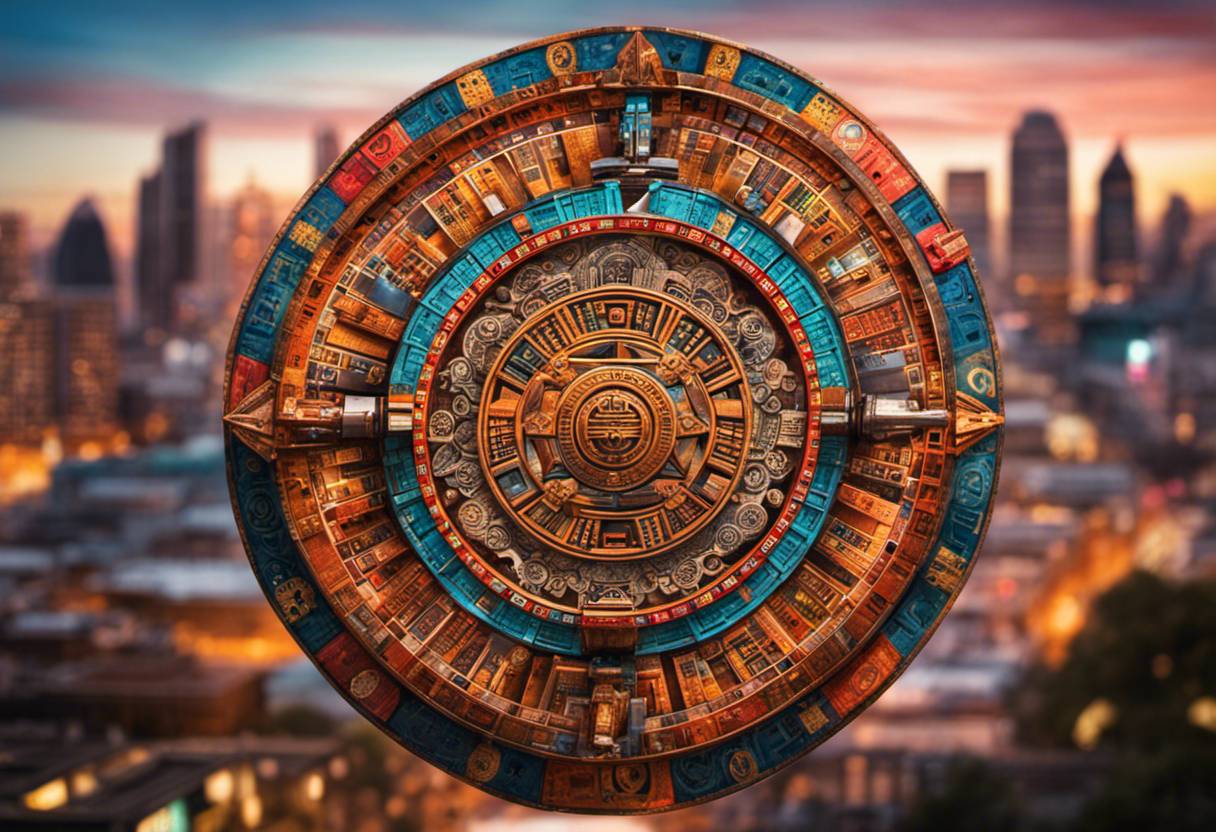

With their intricate design and symbolism, Aztec calendar wheels continue to captivate and inspire modern artists, scholars, and enthusiasts alike. The legacy and influence of these ancient artifacts can be seen in various aspects of contemporary society, ranging from art and fashion to spirituality and cultural identity.
One of the most evident ways in which Aztec calendar wheels have influenced modern times is through their artistic interpretation. Many contemporary artists draw inspiration from the intricate patterns and symbolism found in these ancient calendars, incorporating them into their own artwork. This fusion of ancient and modern aesthetics not only pays homage to the Aztec culture but also creates a sense of connection between past and present.
Furthermore, the Aztec calendar wheels have also influenced modern fashion. The iconic imagery of these calendars can be seen in clothing designs, accessories, and even tattoos. The incorporation of Aztec symbols and patterns into fashion serves as a way for individuals to express their appreciation for the rich cultural heritage of the Aztec civilization.
Beyond the realm of art and fashion, the influence of Aztec calendar wheels extends to spirituality and cultural identity. Many individuals today find meaning and guidance in the symbolism and cycles represented in these calendars. The intricate interplay of time, nature, and cosmic forces depicted in the Aztec calendars resonates with modern spiritual seekers, who seek to connect with deeper universal truths.
Conclusion
In conclusion, the Aztec calendar wheels were a complex and sophisticated system that played a crucial role in Aztec culture. Through the use of symbols and celestial observations, they accurately predicted the cycles of time and guided the rituals and festivals of the Aztec people.
Today, these calendar wheels continue to hold significant cultural and historical value, serving as a reminder of the rich legacy and influence of the Aztec civilization. Their enduring presence in modern times is a testament to their enduring importance.

